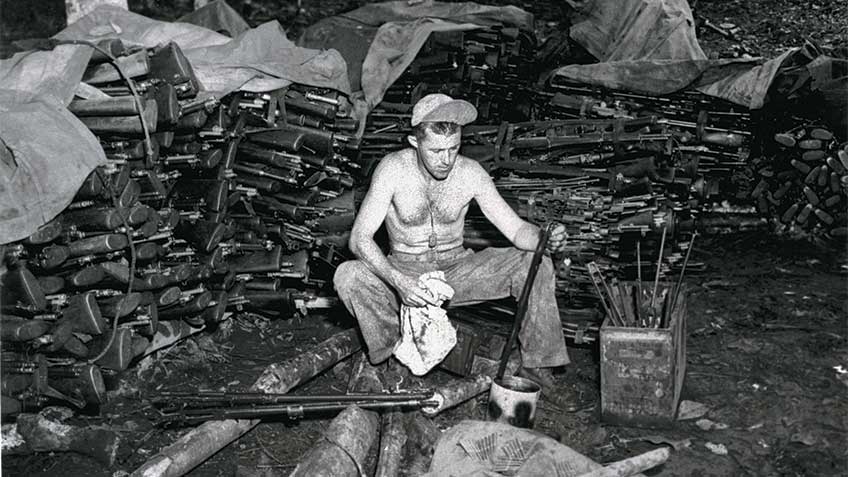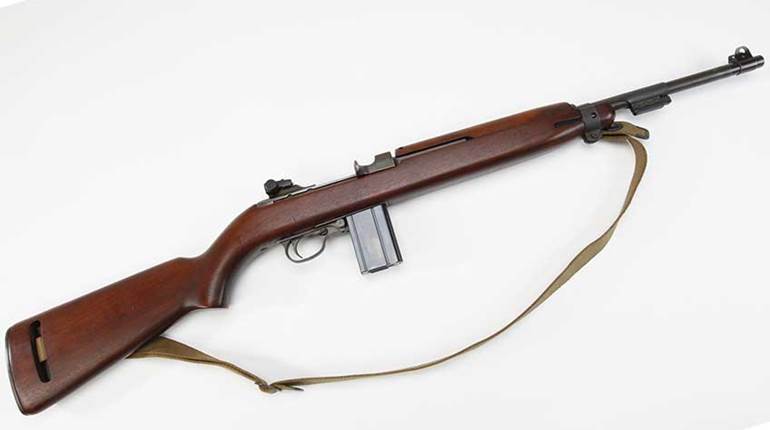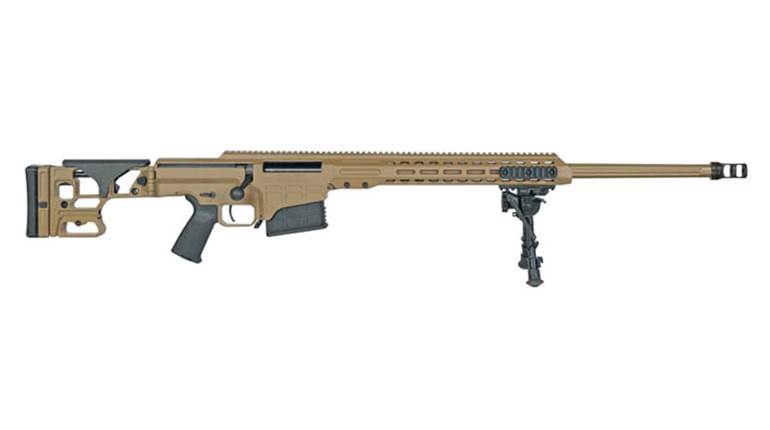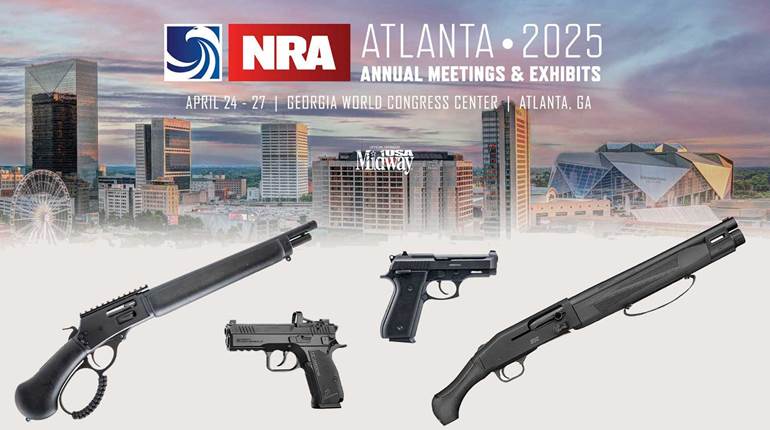
This article, "In the System: M1 Garand Rebuilds," appeared originally in the December 2003 issue of American Rifleman. To subscribe to the magazine, visit the NRA membership page here and select American Rifleman as your member magazine. Above: This member of a U.S. Army Ordnance unit during World War II is cleaning and repairing stacks of salvaged rifles, including many M1s. Such low-level repair and maintenance activities were very common, but substantial repair and modification required the services of a well-equipped ordnance depot or arsenal.
Any mechanical object eventually requires some form of repair or refurbishment, and few objects are subjected to as much use and abuse as military rifles. Whether mishandled by careless recruits or subjected to hard use without cleaning or maintenance on the battlefield, virtually all military rifles require varying degrees of repair and maintenance during their tenure of service.
Basic cleaning and simple maintenance were the responsibility of the soldier, but often a rifle needed repair or maintenance to a degree beyond the capability of individuals. Most routine repair and maintenance procedures were performed by military ordnance personnel in the field or at rear echelon ordnance facilities.
Such work was referred to as “Third or Fourth Echelon Maintenance Responsibilities” in Ordnance manuals. If more extensive work was needed, the arms were sent to an arsenal or ordnance depot, usually in the United States, for overhaul, which was officially referred to as “Fifth Echelon Maintenance Responsibilities.”
Few U.S. military arms were manufactured in greater numbers or saw more extensive use than the venerable “U.S. Rifle, Cal. .30, M1” or M1 Garand. From its adoption in 1936 until production ceased in 1957, well over 5 million M1s were made, and the majority saw widespread service during World War II and the post-war era.
Whether carried in combat overseas or subjected to use by recruits in stateside training camps, virtually all M1s were eventually shipped to an ordnance facility for rebuild at some point, sometimes more than once. Rebuilding enabled worn or damaged rifles to be reclaimed and re-issued as essentially new guns.

The first significant M1 overhaul occurred prior to 1941 when the so-called “Seventh Round Stoppage” problem arose. It was caused by improperly machined receivers. The production tooling was changed, and the issue quickly became a thing of the past. A number of very early M1s were modified at Springfield Armory to correct the deficiency.
Even though Springfield Armory turned out large numbers of M1s during World War II, there was some limited overhaul of M1s during the active war. Most repair and refurbishment was done by overseas ordnance shops due to the difficulty of shipping large numbers of arms from combat zones to the “Zone of the Interior” (continental United States).
Many M1s that would have been overhauled in peacetime were kept in action by the hardworking ordnance personnel in the field or at small base shops. Although such cursory repair work enabled the rifles to continue in service until hostilities ceased, it resulted in large numbers of them needing substantial repair and overhaul at the war’s end. After 1945, the mission of Springfield Armory changed from M1 manufacture to M1 overhaul, along with other types of small arms.
While the specific type of modifications performed during overhaul varied depending on the type of arm being rebuilt, the general practices were similar. Technical Manuals, such as TM 9-1275, detailed the specific procedures to be performed and the equipment (gauges, tools, etc.) necessary for such work.

When M1 rifles were received by an ordnance facility for overhaul, they were unpacked, serial numbers recorded and the arms were degreased as necessary. They were broken down into the major groups; stock group, barrel group and trigger group. The metal parts, except the barrel, were removed and set aside for inspection and gauging.
The wooden components were inspected and repaired, refinished, or discarded as necessary. Barrels and receivers were inspected and gauged to make sure they were within “specs.” Any barrels that proved unusable—due to substantial pitting, wear or excessive throat erosion—were removed from their receivers and scrapped.
Receivers passing inspection were re-Parkerized as required. The other metal components were inspected and gauged. Parts passing inspection were placed in storage bins for subsequent use. Superseded (obsolete) components were replaced, and those that required modification for continued use were altered as necessary.
Major components specific to the M1 that required replacement or modification for continued use were:
Rear Sights: The improved T105E1 rear sight had been adopted near the end of World War II but was not utilized in rifles produced before the end of the war. After circa 1947, most M1s overhauled in ordnance depots had the earlier sights removed and the updated T105E1 pattern fitted.

Some of the World War II-vintage “locking bar” rear sights were retained when the rifles were overhauled after the war, presumably due to a shortage of T105E1s. By the early 1950s, however, virtually all arsenal overhauled M1s were fitted with the updated rear sights.
Operating Rods: The original pattern was found to be subject to cracking at the juncture of the handle and tube. To alleviate the problem, a portion was milled away as part of the rebuild procedure. World War II and earlier vintage operating rods were modified by the addition of the relief cut modification.
Springfield manufactured large quantities of new operating rods with an integral relief cut marked “D35382” for replacement purposes after the war. To illustrate the large number of new operating rods needed for the extensive post-World War II rebuild programs, Springfield made 529,172 replacement M1 operating rods between Fiscal Years 1945 and 1948.
Trigger Housing Pads: From the beginning of production until the middle of World War II, M1 rifle trigger housings were manufactured with a raised portion, termed a “pad,” which was intended to function as a hammer stop.

The original-size pad could sometimes interfere with proper operation of the hammer, and subsequent trigger housings were made with a smaller pad. Post-war rebuild standards specified that the earlier trigger housings have the large pads milled down.
Barrels: Although the basic configuration of the M1’s barrel did not change after World War II, many rifles sent in for overhaul had unsalvageable barrels due, in large measure, to the use of corrosive ammunition. Extreme wear and tear and improper cleaning also contributed to the problem. Springfield manufactured 563,310 new replacement barrels between Fiscal Years 1945 and 1948.
Stocks and Handguards: The basic configuration of the M1’s stock and handguards did not change after World War II. But the wooden components were less durable than most metal parts, and broken, cracked or otherwise unusable stocks and handguards were common.
Stocks and handguards with minor gouges or cracks were repaired by adding “plastic wood” or by inserting brass reinforcing screws and grinding them off flush. Broken or worn stocks were salvaged by adding strips of wood along both sides near the bottom of the magazine area to allow the trigger housing to lock up tightly.
While such repairs might be considered unsightly to collectors, the ordnance workers were only interested in salvaging otherwise usable material and putting as many rifles back into serviceable condition as fast and as inexpensively as possible.

A number of newly made replacement stocks were also fabricated after the war. Between Fiscal Years 1945 and 1948, Springfield made 291,971 replacement stocks. Compared to stocks, handguards were much more prone to damage and were less suitable for repair as illustrated by the number of replacement handguards fabricated by Springfield during the same period: 787,307 front and 893,736 rear handguards.
The above-discussed parts were not the only components needing replacement or modification during overhaul. Indeed virtually all parts of the M1 rifle were subject to replacement, repair or modification.
U.S. Ordnance Overhaul Entities
Springfield Armory: After a rifle was overhauled, ordnance regulations required that the identity of the ordnance facility that performed the rebuild be stamped on the stock. If a rifle had previously been overhauled by the same entity, it was not necessary to re-stamp it, although this happened in some cases.
For rifles overhauled at Springfield Armory from circa November 1945 to August 1947, a cartouche consisting of “sa/shm” was stamped on the left side of the stock. “sa” identified Springfield Armory as the overhaul facility and “shm” represented Col. Stephen H. McGregor, commanding officer of the Armory during that period.
World War II-vintage stocks that were recycled for use after the war (and stamped “sa/shm”) often retained their original 1941-1945 factory inspection cartouche, thus two different stamps of different vintages may be encountered on the same stock.
After Col. McGregor’s departure from Springfield, several types of inspection stamps were used. “sa/spg” represented Stanley P. Gibbs, a civilian inspector who had worked at Springfield for many years and who inspected overhauled M1s until circa 1950. Gibbs’ stamp was similar to the original factory inspection stamp used on the early gas trap M1s made from 1936 to 1940.
In July 1950, Col. James L. Guion was posted to Springfield Armory as commanding officer. M1 rifles overhauled after Col. Guion took command of the Armory were stamped “sa/jlg” on the stock’s left side. A similar final inspection stamp was also used on newly made M1s when the production line reopened in the early 1950s.

When new M1 production began, use of the “sa/jlg” rebuild stamp ceased, and it was replaced by a rebuild stamp consisting of “sa”— often enclosed in a three or four cornered box. Many of these stamps also had a one or two letter code to identify the inspector who supervised the procedure.
This “sa” rebuild stamp was most commonly applied to the left side of the butt. This same type of rebuild stamp was used on many M1 rifles converted to M1D sniper configuration during this period, and the stamp was often hidden by the leather cheek pad found on the sniper rifles.
A number of M1 rifles overhauled at Springfield in 1952 were marked “sa-52” behind the rear sight. Some M1C sniper rifle receivers converted to M1 specifications by plugging the three holes drilled into the left side may also be found with this “sa-52” marking. Applying these markings on the receiver was a departure from the previous practice of stamping rebuild markings on the stocks, and it only lasted for one year.
Rock Island Arsenal: Unlike Springfield, Rock Island did not manufacture large quantities of replacement parts for the M1, but the Illinois arsenal rebuilt large numbers of M1s and myriad other arms from 1941 until the late 1950s.
The scope and nature of the rebuild work performed at Rock Island paralleled that of Springfield. M1 rifles and other arms, rebuilt at Rock Island Arsenal, were stamped on the stock with an “ria” stamp over the initials of the foreman of small arms inspection at the arsenal.

From 1941 to 1946, the stamp was “ria/fk” for Rock Island Arsenal/Frank Krack, who was the foreman during that period. After Krack’s retirement, the stamp was changed to “ria/eb” for Elmer Bjerke who held the position from 1947 to 1958. Therefore, the time frame a particular arm was overhauled can be ascertained.
Other Ordnance Facilities
Other facilities that overhauled M1s, along with other types of arms, during the post-World War II period into the 1950s and 1960s were: Augusta Arsenal (Georgia); San Antonio Arsenal (Texas); Benicia Arsenal (California); Raritan Arsenal (New Jersey); Anniston Arsenal (Alabama); Hawaii Ordnance Depot, Mt. Rainer Ordnance Depot (Washington); and Ogden Arsenal (Utah).
As was the case with Springfield and Rock Island, the arms overhauled by these arsenals and depots were stamped on the stock, usually but not always on the left side, as follows:
Augusta Arsenal—“aa”—Typically with a letter suffix (presumed to be for the inspector supervising overhauls). Later a number suffix (typically four digits) was sometimes added. These markings may be found stamped on either the left or right side of the stock.
Benicia Arsenal—“ba”—Usually consisting of a “ba” over inspector’s initials and enclosed in a box stamped on the left side of the stock.
Hawaii Ordnance Depot—“hod”—Sometimes followed by inspector’s initials. Stamped on left side of stock.
San Antonio Arsenal—“saa”—Usually with a letter prefix. Stamped on left or right side of stock.
Ogden Arsenal—“og”—Often with “e.k.” or “ek” suffix. The “og” or “ogek/o.g.e.k.” stamp may or may not be enclosed in a box. Note: “o.g.e.k.” (enclosed in a box) signified Ogden Arsenal inspector Elmer Keith and “ogek” (not enclosed) signified inspector Ed Klouser. Keith gained fame as a gun writer in the 1940s and 1950s.

Anniston Army Depot—“an”—Often followed by a letter suffix.
Mt. Rainier Ordnance Depot—“mr”—Stamped on left side of stock.
Raritan Arsenal—“ra” or “ra-p”—The “p” is presumed to indicate that the rifle was proof fired as part of the overhaul procedure and was not an inspector initial as was the case with the other arsenals. The “ra” should not be confused with the Remington Arms (“ra”) stamp.
Red River Arsenal—“rra”— Later renamed Red River Army Depot—“rrad”—Markings found with and without periods. The 1960s vintage rebuilds usually have a boxed “p” proofmark stamped on the pistol grip.
Later 1960s M1 Rebuilds
As the Vietnam War heated up in the mid 1960s, additional M1s in the government’s inventory were needed as supplemental service rifles and for military foreign aid requirements. Several U.S. government ordnance facilities were given contracts for the overhaul of more M1s during that period. M1 overhaul work in the 1960s was done primarily by Tooele Army Depot (Utah) and Letterkenny Army Depot (Pennsylvania).

Red River Army Depot and Springfield Armory also overhauled some M1s into the 1960s as well. Unlike the earlier rebuild markings, which were stamped on the stock, these facilities typically utilized identity codes that were hand-etched on the right side of the receiver leg by electric pen.
In most cases, the code was accompanied by the month and year that the rebuild was performed.
The facilities and codes on the receiver legs were as follows: Letterkenny Army Depot, “lead”; Tooele Army Depot, “te”; Springfield Armory, “sa”; and Red River Arsenal/Red River Army Depot,“rra” or “rrad”. In addition to overhauling M1 rifles in the 1960s, Tooele Army Depot converted a number of M1 rifles to M1D sniper configuration.
Some of the facilities stamped a “p” proofmark on the pistol grip of the stock after the rifles were proof fired as part of the final overhaul inspection procedure. Unlike factory proof stamps which consisted of a circled “p”, the overhaul proof stamps were either a block letter “p” enclosed in a square or by itself.
Rifles that were overhauled at overseas ordnance installations were not required to have the initials of the facility stamped on the stock or engraved in the metal, thus not all rebuilt arms will have overhaul stamps.

It should be mentioned that the presence of an arsenal or depot stamp does not always indicate that the arm was actually overhauled. Some guns in excellent, or even near new condition, were sent to the facilities for inspection, minor repair and cleaning but did not require rebuild. Such arms were usually stamped on the stock to indicate they were cycled through the arsenal or depot but may have been otherwise untouched. This was more common for arms, such as ’03A3 rifles, which didn't require the replacement of many obsolete or superseded parts.
Some M1 rifles in serviceable condition sent to ordnance facilities for inspection may have only had superseded parts replaced, such as rear sights and unmodified operating rods, but otherwise remained primarily in their original factory configuration.
The majority of M1 rifles issued to our troops after World War II had been overhauled at some point. The Ordnance Department was recycling M1 rifles and other arms for many years in order to keep our fighting men armed with serviceable and efficient arms.
An arsenal-overhauled, worn or damaged M1 was rebuilt to the same exacting standards as a rifle just off the assembly line, but at a fraction of the cost. Hundreds of thousands of M1s had their useful life extended by several decades through the efforts and dedication of the skilled ordnance personnel "in the system."






































